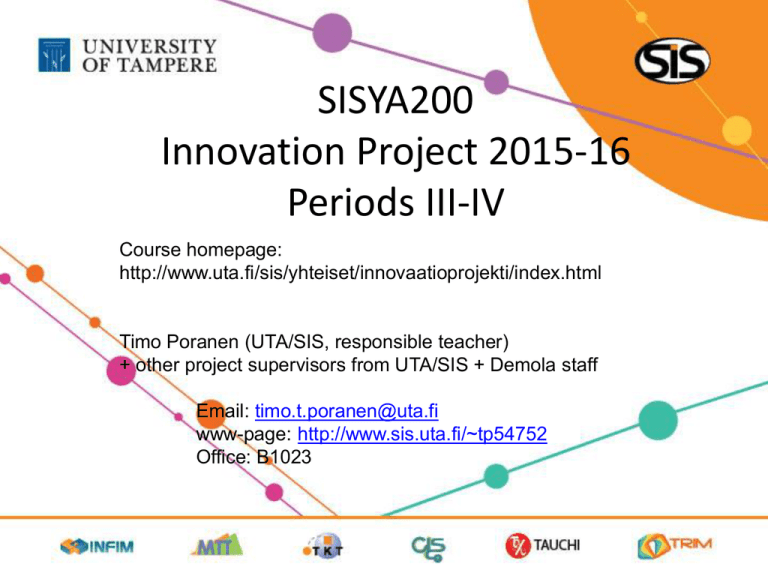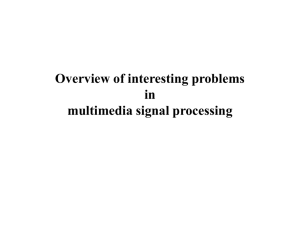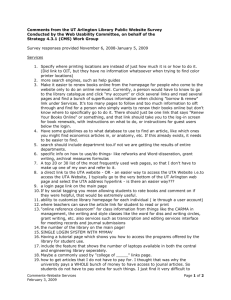Innovation Project 2015S
advertisement

SISYA200 Innovation Project 2015-16 Periods III-IV Course homepage: http://www.uta.fi/sis/yhteiset/innovaatioprojekti/index.html Timo Poranen (UTA/SIS, responsible teacher) + other project supervisors from UTA/SIS + Demola staff Email: timo.t.poranen@uta.fi www-page: http://www.sis.uta.fi/~tp54752 Office: B1023 Initial lecture 14.1.2016 •What is Demola? http://www.youtube.com/watch?v=vDo7u6Fwfaw •Course information: – Curriculum – Cyberman doing intelligent service with smart glasses (Fall 2013) – Nokia Kinetic Prototype of bendable smartphone (Spring 2012) – Example project: LiveManual (project phases) – Credits and grading, schedule – Project management (TIETS19-Practice) at Demola? – Demola profile, project applications – Moodle (course registration, discussion forum), Project blog – Teacher’s role, problems, recommendations, tools •One more sample project: YLE's Virtual Studio + NABC pitch •Questions and answers. Demola - http://tampere.demola.net/ •Video: What is Demola? http://www.youtube.com/watch?v=vDo7u6Fwfaw Curriculum •Course for all SIS students. •Intermediate studies in Computer Science, Information Studies and Interactive Media, and Interactive Technology. •Students work in a project team to produce a demo or an interactive demonstration. – Teams have students from TAMK, UTA and TUT. – Project partner (usually from a company or an association). – Demola facilitators and university supervisors support the team. •The course is organised with Demola and teams work daily in the Demola premises. •Project topics are related to new technology and services (new mobile phones, innovative www/mobile applications, cyber glasses, augmented reality, games, new service concepts, drones, robots, etc.). •Learning goals: http://www.uta.fi/sis/yhteiset/innovaatioprojekti/curricula.html Course’s suitability •I have studied course TIEA4 (Project Work). Can I still take Innovation project? – Yes. Your credits can be used in other studies -category. •Can I study Innovation Project (SISYA200) instead of Project Work (TIEA4)? – Yes. But you can always take them both. •I’m studying in Master’s Degree Programme in Software Development. Can I study Innovation Project (SISYA200) instead of Project Work (TIEA4)? – Yes, SPM (TIETS19) does not anymore require TIEA4. – But you can still take TIEA4, because these projects are more software development oriented. •I'm majoring in Information studies and interactive media. Can I study Innovation Project (SISYA200) instead of Interactive Media Project (ITIMA25)? – Yes. Project management (TIETS19-Practice) at Demola? •I would like to get credits from TIETS19-Practise from a Demola project. Is that possible? Yes. •You must have studied earlier Project Work (TIEA4) and/or Innovation Project (SISYA200) and (TIETS19/Theory, Software Project Management - Theory). •Then you normally apply for a Demola project. In the application, mention that you are interested in doing project management tasks in your project (among other things!). •Then you participate normally in your Demola-project, but you must be active in project management related tasks (initiating, planning and design, executing, monitoring and controlling, communication, reporting, presentations, etc.). •Your name should be mentioned in the Playbook when management-related tasks are listed. •Supervising teacher gives more information on required activities in the project meetings. Project lifecycle •Reviews: Project plan (Playbook) review, 2 mid-project reviews, Final version of the Playbook + review. •Iterative project cycle: 1) brainstorm, analyse and design, 2) build a demo, 3) evaluate your demo. •Deliverables: Playbook (Project plan), final report (updated Playbook), three NABC (Need, Approach, Benefits, Competition) pitches (“presentations”), project blog and Demo. There might be other deliverables too! •Workshops. Kick-off and graduation events. A sample project - LiveManual Source of the picture: http://www.tampereenkauppakamarilehti.fi/2012/pirkanmaan_taloudessa_ta pahtuu/tal_tap_3_12_4.php LiveManual – project phases 1. Project Requirements Gathering - regular meetings with Metso to understand their needs. 2. Requirements Analysis - brain storming, listed all ideas which we thought of and realized them one by one based on the priority and implementation difficulty. 3. Concept Design – define what the new demo should be like, what kind of features should be there, for example how to show the navigation column etc. Draw different versions of the interface. Proceed based on these. Searched needed resources from the internet, self learning and transfer all those new ideas and knowledge into our product. LiveManual 4. Development – added needed features one by one. Meanwhile, continued to improve the interface design and made it look better. 5. Integration – put different parts together and integrate with the database. 6. Testing – we devised questionnaires and tested the manual. The test requirements and description were prepared in advance. The first test was done with some volunteers, the test subjects were students and those students had some IT related knowledge. The second test was done in Metso, with staff from different backgrounds. The test results were collected and discussed based on feedback and comments. Some issues that came up in the tests were fixed. 7. Demonstration & Possible Deployment – show the demo in the final customer meeting, if the customer wants, they can license the demo. Credits and grading •Credits are based on amount of (productive) work in your project. 1 ECTS corresponds to 20 hours of work in your project (5 ECTS equals to 100-119 working hours, 10 ECTS equals to >200 hours). •All students should work at least 100 hours (= 5 ECTS) for their project. •All team members log their personal working hours. •Grading is based on the process, outcome and personal activity in the project. Schedule – main deadlines •http://www.uta.fi/sis/yhteiset/innovaatioprojekti/schedule.html •Join Moodle forum of the course no later than 31.1.2016. •Create Demola profile and apply for projects 31.1.2016. •Playbook (Project plan) deadline in February, a review after that. •Team meets the partner regularly. Invite teachers to “milestone” meetings. •Final project report deadline in May, a meeting after that. •Graduation event in May 2016. •Credits and grading: May / June 2016. •Training sessions, workshops, Demola jams, group work, and other project activities. Pitching (three times). Demola profile, project applications •Create a Demola profile and apply for interesting projects no later than 31.1.2016. •Pay attention on writing a good application. Skills and motivation are important. •You may (and should!) apply to different projects but you’ll be selected to one project. •In your profile/application tell your experiences, skills, hobbies, wishes, etc. •Demola staff will inform you on your project in a week after the application deadline. •It is possible that there is no suitable project for you . Moodle •All UTA/SIS students must join course’s Moodle forum. • https://learning2.uta.fi/course/view.php?id=3444 • Forum name: SISYA200 Innovation project – Spring 2016 •All important course messages (to UTA/SIS students) will be sent to the “News” forum. Demola has own information channels for their messages / news / guidelines to project teams (on workshops etc.). •Moodle’s discussion forum can be used for asking/commenting project/course related questions. •A short questionnaire after the project. To get credits you must answer the questions. Project blog •Project blog is a public web-based diary, where project team publishes the current status of the project. The project blog shows how the project is progressing in general. •Blog uses Demola’s project platform. Other platforms are also ok. •Regularity: Weekly. •It is important to bring out some key issues and challenges concerning the current stage of the project. •Team should divide the blogging so that each team member writes the project blog at some point. •Check: Project blog cartoon (from “guidelines”). Working hours •Each team member maintains a list of his / her working hours. •Working hours are reported in the end of the project in Project report. •An easy way to maintain working hours: • Shared Google drive sheet (name, day, hours, activity) • Timo, 6.2.2016, 2 hours, UI design •Be ready to show your team’s hours in your meetings. Development tools • http://www.uta.fi/sis/tie/pw/tools.html • Subversion - version control for code • Balsamiq - UI design tool • Redmine - project management • Trello for project management (Kanban board), Slack or Flowdock for communication, GitHub or BitBucket source code. • Invisionapp for UI design. • Prezi for presentation. Teacher's role •Each student has a responsible teacher assigned to him/her from the course. A team might have up to three supervisors from different universities! •Teachers are there to support your learning and to help you – Checking how you are doing. – To give help and support when you need it. – To watch the amount and quality of your work to verify that you can pass the course. •Teachers participate in main project meetings (Playbook etc.) and give feedback based on those. (They don't have time to participate in all meetings.) – Make sure that the teacher knows when you have milestone meetings. Guidelines •http://www.uta.fi/sis/yhteiset/innovaatioprojekti/guidelines.html •Important - All students should read these: – Central_principles_of_project_work_checklist.pdf: Central principles of project work (PDF, Important!) – Co-creation_meetings_checklist.pdf: Co-creation meetings checklist (PDF) – Student_checklist.pdf: Checklist for a student in a team (PDF, Important!) – Project blog guidelines (PDF, important) •Optional – Checklist for project partner (PDF) – Demola-academy-students.pdf: Slide set for students (PDF) Problems in your project? •It is normal that when a group of people is working together in a technical project, there might be problems with – Team members – Client – Technical devices – Design and implementation – Etc. •All teams should be able to solve “small problems” together, but in case of serious problems, contact project supervisor and Demola staff. •Tell about your project obstacles in review meetings and in the project blog. Findings from earlier projects •Meet your team at least weekly! Your project needs roughly 10-15 hours work / week. •More group work instead of working alone, participate in workshops. •Do not forget to inform your university supervisor on your project reviews. Preferably, days and times should be agreed in advance in the Playbook review. •Use good project working practices: send a meeting agenda beforehand and write down meeting minutes (and send to all stakeholders). •Put your project’s name in email’s subject field. •Select and use suitable tools, enough management, … •Communicate (facebook, face-to-face, email,…). •Update project plan regularly and/or maintain tasks / work packages using some tool (excel, project management sotware,…). YLE’s Virtual Studio Project •Website: http://tampere.demola.net/projects/capturingmotion-yle%E2%80%99s-virtual-studio •Tohloppi’s VIRTU is the only virtual studio in Finland that functions in daily production use. How could we utilize motion capture in our productions? •NABC from “mid project” pitching: http://www.youtube.com/watch?v=PGtQG5pfR0o •Efficient communication: blog posts, facebookgroup. Questions and answers?




